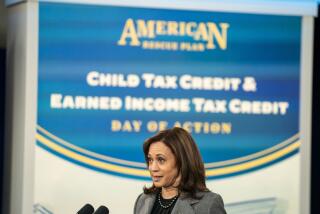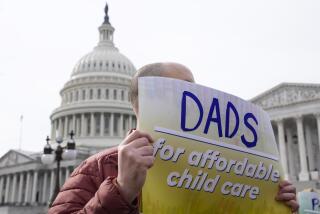UPDATE / CHILD CARE : Most Agree That Something Should Be Done--but How?
- Share via
WASHINGTON — Sometimes, the long-awaited legislation on child care seems like a motherless child.
Almost everyone seems to agree that the federal government should do more to help poor families meet child care expenses, but there is sharp conflict over how to do it.
One child care bill passed the Senate more than a year ago. Another version struggled through the House last fall. The White House has threatened a veto of the final bill if it fails to meet President Bush’s own principles.
Now the legislation seems to be languishing in a Senate-House conference with no agreement in sight.
VARIED APPROACHES: The impasse reflects basic philosophical differences. One approach, favored by Bush, would provide payments to poor families through income tax credits, allowing them to use the money to select their own child care providers. Another alternative, preferred by most Democrats, would give federal funds to states for allocation to needy families, expansion of child care facilities and creation of new school-based programs for poor children.
Bush has favored using the tax system exclusively. The Senate has focused primarily on federal grants to state agencies. The House, unable to reach a compromise, incorporated both methods in hopes that an agreement could be worked out in conference.
Now it appears that only major decisions by the Democratic leaders in the Senate and House can rescue a bill that once seemed to be every politician’s darling in the 1988 campaign.
“We can’t imagine the Congress will let another year go by without taking action on child care,” said Mary Bourdette, a lobbyist for the Children’s Defense Fund, a prime mover behind the legislation.
Yet time is running out during this session, in view of a monthlong recess set for August followed by the inevitable election-year adjournment rush.
COMPROMISE PLAN: There has been some movement. A conference subcommittee agreed to authorize $1.75 billion a year for a variety of child care programs, including an enlarged Head Start that would function all day and all year to help underprivileged children.
Under the compromise, at least 75% of the $1.75 billion would be earmarked for child care to poor families through the use of vouchers, contracts or grants.
The plan would give parents a wide choice of providers--including commercial and nonprofit groups, family day care homes and church-sponsored centers. It would require states to set their own standards for health, safety and other areas within three years.
As envisioned by proponents, the compromise would be one facet of a wide-ranging bill that also would include an undetermined amount of tax credits.
Another conference subcommittee is trying--without success, so far--to decide how much child care should be provided in the form of tax credits to working parents.
Under the more generous House bill, tax credits or direct payments to families with one or more working parents would total $18.5 billion over five years, in addition to the $1.75 billion under the federal-state program. The Senate, however, had earmarked only $2.8 billion over five years for tax credits, concentrating more funds for government grants.
BUSH’S OBJECTIONS: The White House, meanwhile, has been critical of various proposals, such as the $1.75 billion in block grants or a school-based program for “latchkey children” of working parents.
As a result, Democratic leaders must decide whether to shape the legislation to overcome Bush’s objections or approve the kind of bill they prefer.
It appears that the issue will come to a climax this fall--shortly before the November elections--when interest in child care may again revive.
More to Read
Get the L.A. Times Politics newsletter
Deeply reported insights into legislation, politics and policy from Sacramento, Washington and beyond. In your inbox three times per week.
You may occasionally receive promotional content from the Los Angeles Times.










